The amount of electrical energy (kWh) that a solar panel produces over a certain period of time depends on the amount of sunlight that it has received over that same period.
Reversibly, the size of the system that you need to produce a certain amount of energy (2000 kWh in this case), will also depend on the amount of sunlight that will generally be available for the solar panels to convert into electrical energy.
In other words, to estimate how many solar panels you would need to offset 2000 kWh of monthly energy consumption, you’ll first need to estimate the average amount of sunlight that these solar panels would receive.
This amount of sunlight is quantifiable and is referred to as Peak Sun Hours.
But don’t worry, you won’t need special equipment to get your estimates. In fact, all you need is an address, and in this article, I’ll explain exactly how that works.
After reading this article, you’ll have a pretty accurate estimate of how many solar panels you’ll need for 2000 kWh of monthly energy consumption, and how much it would cost to install the system.
How many solar panels do I need for 2000 kWh per month?
As a rule of thumb, a system that could produce 2000 kWh per month, would be rated at around 14 kW (kilo-Watts) of power. A system of this size would roughly consist of about 44 residential solar panels that are each rated at 330 Watts (0.33 kW).
However, it is important to note the following:
- The size of the system, or the number of solar panels that you’ll need, will directly depend on the amount of sunlight that’ll be available to the solar panels throughout the year.
- And the amount of sunlight that will be available to your solar panels, will mainly depend on your location.
For example, while a household in Colorado Springs, CO would require 34 residential solar panels that are rated at 330 watts each, a household in Columbus, OH would require about 44 of the same solar panels to produce an annual average of 2000 kWh of energy per month.
Before I explain how you can actually use your exact location to estimate how many solar panels you’ll need, let me provide some more perspective.
For reference, I’ve compiled a table that estimates the average size of the system (in kW) and the number of solar panels that would be required to produce an annual average of 2000 kWh of energy per month, and how much it would cost to install the system in different cities from each state in the U.S.:
| State | Required System size (kW) to produce 2000 kWh per month | Required number of residential solar panels (rated at 330W) to produce 2000 kWh per month | Estimated Cost (Before Tax Credit) |
| Alabama (Montgomery) | 13.75 kW | 42 | $33,700 |
| Alaska (Juneau) | 31.2 kW | 95 | $75,000 |
| Arizona (Phoenix) | 11.3 kW | 35 | $27,500 |
| Arkansas (Little Rock) | 14.3 kW | 44 | $43,700 |
| California (Sacramento) | 12.5 kW | 38 | $35,700 |
| Colorado (Denver) | 13 kW | 40 | $44,700 |
| Connecticut (Hartford) | 16 kW | 49 | $51,500 |
| Delaware (Dover) | 15 kW | 46 | $41,200 |
| Florida (Tallahassee) | 13.8 kW | 42 | $35,600 |
| Georgia (Atlanta) | 14.3 kW | 44 | $45,700 |
| Hawaii (Honolulu) | 12.7 kW | 39 | $33,900 |
| Idaho (Boise) | 14.3 kW | 44 | $41,900 |
| Illinois (Springfield) | 15.4 kW | 47 | $48,600 |
| Indiana (Indianapolis) | 15.9 kW | 49 | $57,700 |
| Iowa (Des Moines) | 15.5 kW | 47 | $53,400 |
| Kansas (Topeka) | 14.5 kW | 44 | $34,600 |
| Kentucky (Frankfort) | 15.7 kW | 48 | $36,700 |
| Louisiana (Baton Rouge) | 13.8 kW | 42 | $43,700 |
| Maine (Augusta) | 16.3 kW | 50 | $56,200 |
| Maryland (Annapolis) | 15 kW | 46 | $46,900 |
| Massachusetts (Boston) | 15.7 kW | 48 | $55,500 |
| Michigan (Lansing) | 16.7 kW | 51 | $63,100 |
| Minnesota (Minneapolis) | 16.2 kW | 49 | $55,800 |
| Mississippi (Jackson) | 14 kW | 43 | $36,900 |
| Missouri (Jefferson City) | 15 kW | 46 | $42,700 |
| Montana (Montana City) | 15.7 kW | 48 | $37,900 |
| Nebraska (Lincoln) | 14.5 kW | 44 | $41,000 |
| Nevada (Carson City) | 12 kW | 37 | $31,200 |
| New Hampshire (Concord) | 16.25 kW | 50 | $58,600 |
| New Jersey (Trenton) | 15.4 kW | 47 | $45,400 |
| New Mexico (Santa Fe) | 11.8 kW | 36 | $40,000 |
| New York (New York) | 16.5 kW | 50 | $57,400 |
| North Carolina (Raleigh) | 14.3 kW | 44 | $43,400 |
| North Dakota (Bismarck) | 15.5 kW | 47 | $37,500 |
| Ohio (Columbus) | 16.1 kW | 49 | $47,900 |
| Oklahoma (Oklahoma City) | 13.4 kW | 41 | $35,100 |
| Oregon (Salem) | 17.3 kW | 53 | $54,100 |
| Pennsylvania (Harrisburg) | 15.8 kW | 48 | $48,300 |
| Rhode Island (Providence) | 15.75 kW | 48 | $56,800 |
| South Carolina (Columbia) | 14 kW | 43 | $40,400 |
| South Dakota (Pierre) | 15 kW | 46 | $35,800 |
| Tennessee (Nashville) | 15.3 kW | 47 | $45,400 |
| Texas (Austin) | 13.75 kW | 42 | $38,000 |
| Utah (Salt Lake City) | 13.75 kW | 42 | $36,900 |
| Vermont (Montpelier) | 17.2 kW | 53 | $54,000 |
| Virginia (Richmond) | 15 kW | 46 | $45,600 |
| Washington (Washington) | 15.1 kW | 46 | $49,000 |
| West Virginia (Charleston) | 16 kW | 49 | $46,700 |
| Wisconsin (Madison) | 16.25 kW | 50 | $55,400 |
| Wyoming (Cheyenne) | 13.8 kW | 42 | $35,400 |
Please note that the values provided in the table only correspond to one city from each state, and do not represent the whole state. Different areas in the same state might require different system sizes to produce the same amount of energy.
For example, to produce an annual average of 2000 kWh per month, a household in the city of Beaumont, Texas would require a 14.2 kW system, which would consist of about 44 solar panels (rated at 330 Watts each).
On the other hand, a household in Odessa, Texas would only require 11.7 kW of solar power, equivalent to about 35 (330W) solar panels.
This difference in required system sizes is simply due to the fact that these two areas receive different amounts of sunlight throughout the year.
To illustrate this, here’s an image that compares the annual average amount of sunlight that different parts of Texas receive throughout the year:
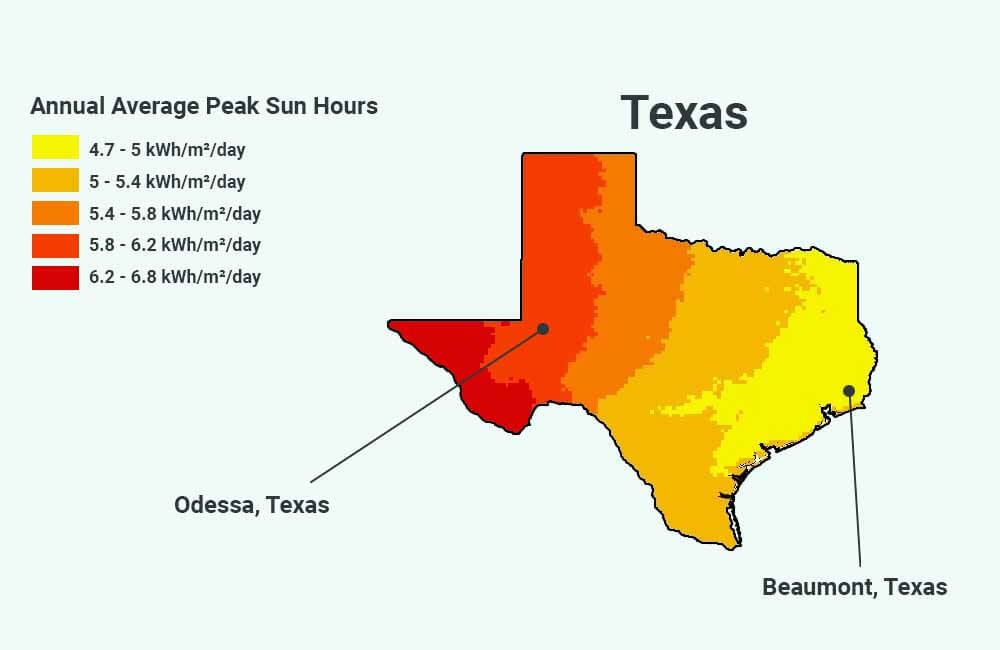
In the image, you can see that the western part of Texas receives more sunlight throughout the year than its eastern part.
To make sure your estimates are as accurate as possible, you’ll have to base them on the exact location of the installation.
Before I show you an easy way to do that, let me first explain how sunlight is actually measured, and how its unit of measurement is used to estimate the amount of energy that solar panels produce, or reversibly, estimate the size of the solar system that is required to produce a certain amount of energy.
Explaining Peak Sun Hours: How much sunlight do you get?
The amount of energy that an area receives from the Sun over a certain period of time (a day for example) is measured in “kWh/m²” (kiloWatt-hours per square meter) and is referred to as “Peak Sun Hours”.
For example, if an area receives 5 kWh/m² of sunlight energy on a daily basis, it could be said that the same area receives 5 Peak Sun Hours per day.
But why is this important?
Well, historical Peak Sun Hours data in a certain area can be used to estimate the Energy Production potential of a solar system in that same area. This is done using the following formula:
Energy Production of a solar system (kWh) = Power Rating of the solar system (kW) x Peak Sun Hours
For example, if we install a 10kW solar system in an area that – on average – receives 5 Peak Sun Hours per day, the daily energy production of our system can be estimated as such:
Daily Energy Production (kWh) = Power Rating of the solar system (kW) x Daily Peak Sun Hours
Daily Energy Production (kWh) = 10 kW x 5 Daily Peak Sun Hours
Daily Energy Production (kWh) = 50 kWh/day
Reversibly, if the desired amount of energy production is known, and the Peak Sun Hours in the area are also determined, the required size of the solar system can be calculated as such:
Power Rating of the solar system (kW) = Desired Daily Energy Production (kWh) ÷ Daily Peak Sun Hours
For example, let’s say we need to determine the Power rating (kW) of a solar system that would – on average – produce 2000 kWh per month in an area that receives 5 Peak Sun Hours per day.
To produce 2000 kWh of energy per month, our system must produce 66 kWh of energy per day (2000 kWh/month ÷ 30 Days = 66 kWh/Day). Using these pieces of information, we can estimate the size of our system as such:
Power Rating of the solar system (kW) = Desired Daily Energy Production (kWh) ÷ Daily Peak Sun Hours
Power Rating of the solar system (kW) = 66 kWh ÷ 5 Peak Sun Hours
Power Rating of the solar system (kW) = 13.2 kW
According to these calculations, in order for our solar system to produce 2000 kWh of energy per month or 66 kWh per day, it must be rated at 13.2 kiloWatts (or 13000 Watts) or more.
If you don’t yet know the difference between kW (kiloWatts) and kWh (kiloWatt-hours), feel free to read up on the subject here: kW vs kWh (The difference between Power and Energy)
Now, that we know what Peak Sun Hours are, and how they can be used to size solar systems, let me show you an easy way to determine the Peak Sun Hours in your location.
How many Peak Sun Hours do you get per day?
The PVWatts Calculator, made available by the National Renewable Energy Laboratory (NREL), is a free tool that uses historical weather data to estimate the average Peak Sun Hours that a location receives each day.
To access the Peak Sun Hours data in your location, you’ll first need to submit your address (or the location of the installation) here:
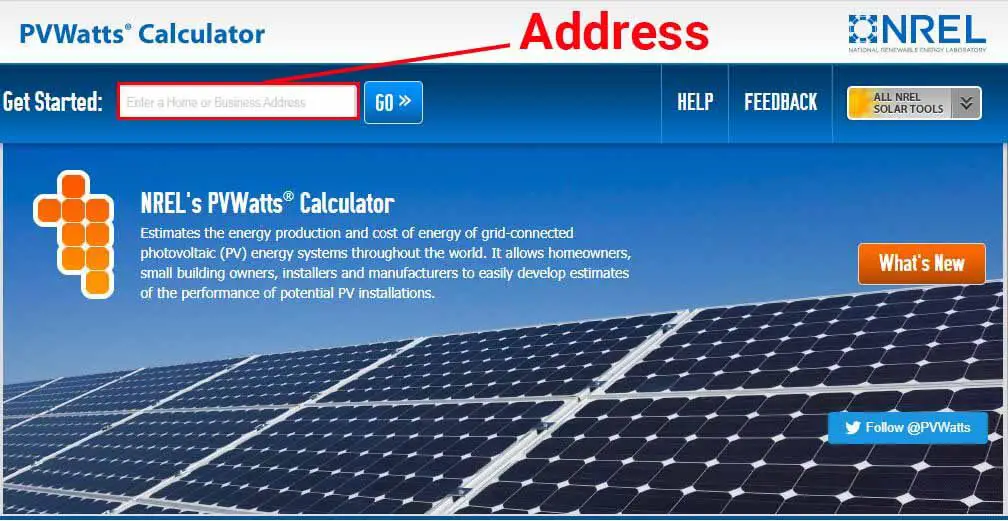
Based on the location, the tool will estimate the annual and monthly averages of the Peak Sun Hours that the solar panels would receive on a daily basis.
As an example, I submitted Tuscon, AZ as my address, and in the “Results” section, the PVWatts Calculator provided the following table:
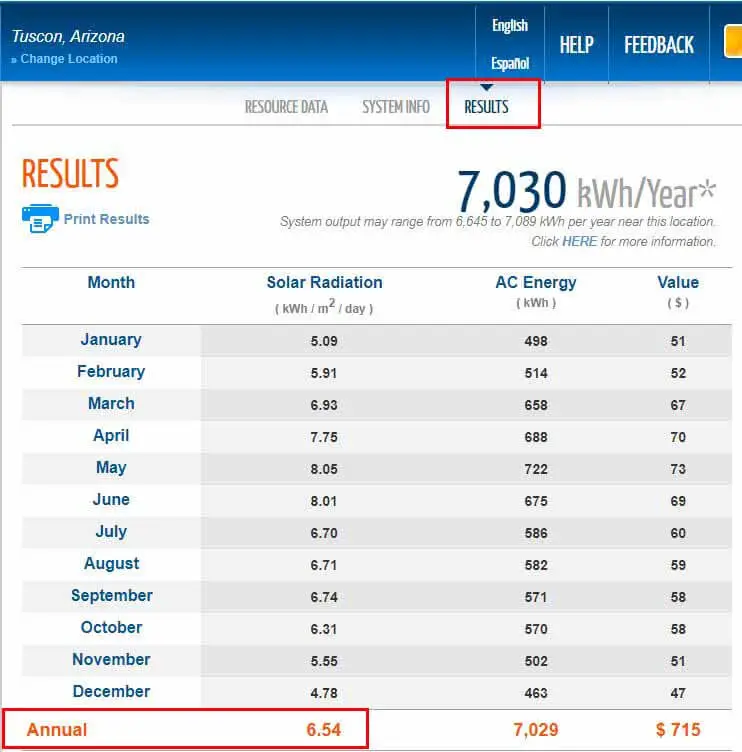
In the second column of the table, you can see that the calculator provides values with this unit: kWh/m²/day. As explained above, 1 kWh/m²/day is equivalent to 1 Peak Sun Hour per day.
At the bottom of the table, you can see that calculator estimates that the city receives 6.54 Peak Sun Hours per day on average (annual average). In other words, the tool estimates that the city of Tuscon, AZ receives – on average – 6.54 kWh/m² of sunlight energy per day.
Now, 6.54 kWh/m²/day (Peak Sun Hours) is the “Annual Average”, which is simply all the Peak Sun Hours received throughout the year, divided by 365.
However, the calculator also provides “Monthly Averages”, which represent the average number of daily Peak Sun Hours received in each month. These monthly averages are pretty useful when sizing off-grid systems. But in our case, all we need is the Annual average value.
It is also important to note that the tool assumes that your solar panels will be installed on a roof section that:
- Faces due South (Azimuth angle = 180 deg)
- Has a 20-degree tilt (4-5/12 roof pitch)
However, these default values can easily be modified in the “System Info” section of the calculator.
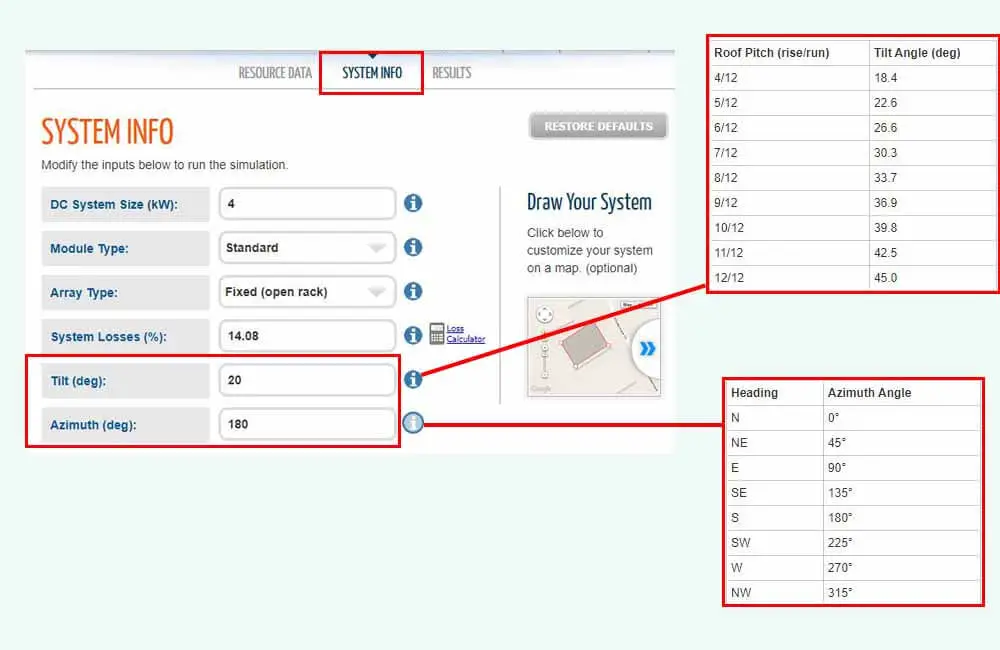
The direction that a solar panel faces, also known as its Azimuth or its Heading, and the angle at which the solar panel is tilted, both influence the amount of energy the solar panel produces. Therefore, to get accurate estimates, make sure to submit the correct Azimuth and Tilt Angles.
If you don’t know the exact Azimuth angle of the roof section that can be used for the solar panels, you can use apps such as Commander Compass Go for iOS or Azimuth Compass for Android to determine the Azimuth angle.
And if you don’t know the exact Tilt Angle of the roof, you can use apps such as Measure for iOS or Bubble Level for Android to determine the tilt angle of that roof section.
In any case, once you have a Peak Sun Hours estimate, feel free to use the following calculator to determine the size of the system that would produce 2000 kWh/month of energy in your location.
Solar panels kWh calculator:
The following calculator estimates the number of solar panels that you need, and how much it would cost to have them installed in your state, based on your monthly energy consumption and the average number of Peak Sun Hours that you get each day.
I used the value from the example above (6.54 Peak Sun Hours), and here are the results:
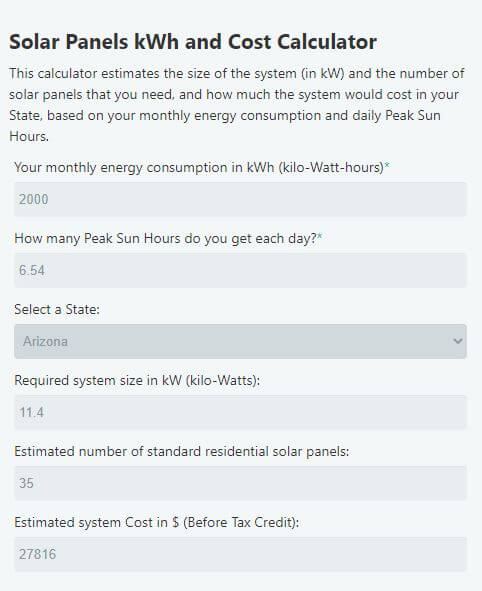
The calculator estimates that a household in Tuscon, AZ, with an average energy consumption of 2000 kWh per month, requires an 11.4 kW system to offset 100% of this energy consumption.
Such a system would consist of approximately 35 residential solar panels and is estimated to cost around $27800 (Before Tax Credit).
Please note that the average residential solar panel is rated at 330 Watts. To learn more about residential solar panels, their power ratings (Wattage), sizes, etc., please refer to this article.


We are a group of volunteers and starting a new scheme in our community. Your web site provided us with valuable information to work on. You have done a formidable activity and our whole community can be thankful to you.
Thanks for sharing! Very informative and helpful